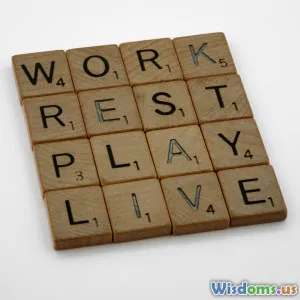
8 Mindset Hacks for Crushing Your Goals
9 min read Unlock your potential with 8 proven mindset hacks to smash your goals and boost your success. (0 Reviews)
8 Mindset Hacks for Crushing Your Goals
Achieving significant goals can often feel like navigating a storm without a compass. Many people set ambitious goals but falter before reaching the finish line—not for lack of effort, but because of the mental blocks and unproductive habits that stealthily sabotage progress. What if you had a toolbox of mindset hacks to not only push past these hurdles but to crush your goals with confidence and consistency?
In this article, we'll dive into eight scientifically-backed and practical mindset shifts that high achievers swear by. These aren’t just feel-good clichés; these are actionable strategies that, when implemented, prime your brain for success and fuel unstoppable motivation.
1. Cultivate a Growth Mindset
Coined by psychologist Carol Dweck, the growth mindset is the belief that abilities and intelligence can be developed with effort, strategies, and persistence. This contrasts with a fixed mindset, where people assume talents are innate and unchangeable.
Why it matters: Embracing a growth mindset turns failures and setbacks into valuable learning experiences rather than proof of incompetence. For example, when Thomas Edison’s countless attempts to invent the lightbulb failed, his perspective that each failure was a step closer to success kept him going.
How to apply:
- Reframe failures as feedback: Instead of thinking "I can't do this," try "What can I learn from this?"
- Celebrate effort over outcome, both for yourself and others.
- Challenge limiting beliefs by asking, "What’s possible if I put in more effort or try a different approach?"
According to research published in Psychological Science, students with a growth mindset showed significantly improved performance compared to those with a fixed mindset — proof that mindset alone can influence goal achievement.
2. Set SMART and Chunked Goals
Clear goals are essential, but specificity makes them compelling. The SMART goals framework (Specific, Measurable, Achievable, Relevant, Time-bound) removes ambiguity, which often paralyzes progress.
Moreover, large goals can feel overwhelming. Breaking them into smaller "chunks" creates manageable milestones, fostering a sense of achievement and momentum.
Example: Instead of "I want to write a book," a SMART chunked goal would be:
- Write 500 words daily for three months;
- Complete one chapter every two weeks.
A 2011 study in Journal of Applied Psychology found that goal proximity (breaking down goals) increases motivation to persist, demonstrating why chunking works.
3. Harness the Power of Visualization
Elite athletes and successful entrepreneurs alike use mental imagery to prepare for challenges. Visualization is the practice of vividly imagining your goal and the process of achieving it.
Why it helps: Visualization creates neural patterns similar to actual performance, priming your brain for success. It also clarifies the steps you need to take by mentally rehearsing them.
Tip: Spend 5-10 minutes daily visualizing not just the end goal but the actions you will take, possible obstacles, and how you'll overcome them.
For example, Olympian Michael Phelps attributed part of his success to rigorous mental rehearsal, claiming he “saw himself winning” repeatedly before stepping onto the pool deck.
4. Practice Self-Compassion to Avoid Burnout
Goal-crushing isn’t about relentless grind; it’s about sustainable progress. Research from Kristin Neff, a pioneer in self-compassion studies, shows that individuals who treat themselves kindly in moments of failure experience higher motivation and less anxiety.
Self-criticism can create a vicious cycle of decreased motivation and increased stress, which undermines goal pursuit.
Self-compassion strategies:
- When you slip, consciously acknowledge that everyone faces setbacks.
- Replace harsh self-talk with encouraging language.
- Recognize your intrinsic worth isn’t tied to performance.
A study in Motivation and Emotion (2015) reported that students practicing self-compassion displayed better coping strategies and were more likely to persist through adversity.
5. Cultivate Habit Stacking
Habits automate behavior, reducing willpower expenditure. Habit stacking links a new behavior to an existing routine, making goal-oriented habits easier to adopt.
Example: If your goal is to practice daily meditation, stack it by saying, “After I brush my teeth in the morning, I will meditate for 5 minutes.” This leverages an established cue (brushing teeth) to trigger the new habit.
This technique is championed by behavior expert James Clear in his book Atomic Habits and has been shown to significantly increase habit formation success.
6. Manage Your Energy, Not Just Your Time
Legendary writer Maya Angelou was known for renting a hotel room to write uninterrupted, illustrating the importance of managing energy and environment.
Research at the University of California suggests that willpower — key to working toward goals — is a finite resource taxed by distractions, fatigue, and stress.
Techniques to optimize energy:
- Schedule demanding tasks during peak energy hours.
- Incorporate regular breaks using methods like the Pomodoro Technique.
- Prioritize sleep and nutrition to keep cognitive function sharp.
For example, billionaire Warren Buffett opts to allocate his energy strategically, famously saying, “The difference between successful people and really successful people is that really successful people say no to almost everything.”
7. Surround Yourself with Positive Influences
Your social environment massively influences mindset and habits. Being around optimistic, driven people can elevate your motivation and provide accountability.
A 2007 study in the New England Journal of Medicine found that habits like smoking and obesity can spread through social networks. This illustrates the flip side — positive behaviors and attitudes can also propagate.
How to implement:
- Join interest groups or mastermind communities aligned with your goals.
- Engage mentors who inspire and challenge you.
- Distance yourself compassionately from toxic influences that drain enthusiasm.
8. Reflect and Adjust Regularly
Successful goal-crushers treat their efforts as a continual cycle: Plan → Act → Reflect → Adapt. Reflection clarifies what’s working and what isn’t, reducing wasted effort and frustration.
For instance, business leaders like Jeff Bezos emphasize experimentation and iteration as keys to success.
Try weekly or monthly reviews where you:
- Assess progress and celebrate wins.
- Identify obstacles or unproductive habits.
- Adjust strategies or redefine milestones as needed.
This process builds resilience by positioning challenges as opportunities for growth.
Conclusion
Crushing your goals demands more than just ambition—it requires a strategic mindset upgrade that preps your brain and habits for sustained success. By integrating these eight mindset hacks—growing your beliefs, setting clear goals, visualizing, practicing self-compassion, building habits, managing energy, cultivating supportive environments, and reflecting regularly—you transform scattered effort into focused progress.
Remember, legendary sprinter Usain Bolt once said, “I don’t think limits.” With the right mindset, neither should you. Start applying these hacks today and watch as your aspirations shift from distant dreams to achievable realities.
References:
- Dweck, Carol S. Mindset: The New Psychology of Success.
- Clear, James. Atomic Habits.
- Neff, Kristin. Research studies on Self-Compassion.
- Various scientific journals: Psychological Science, Journal of Applied Psychology, Motivation and Emotion, New England Journal of Medicine.
Rate the Post
User Reviews
Popular Posts





















